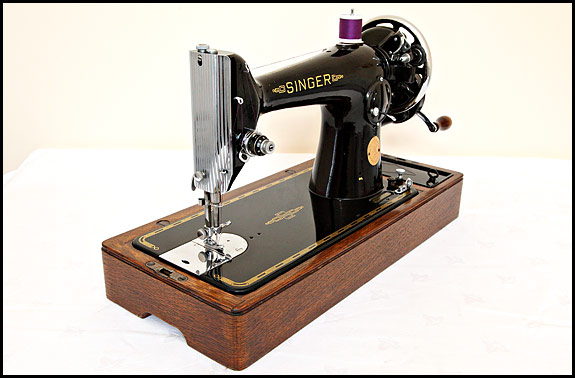This is another of Syd’s leaflets which he kindly let me scan a week or two ago, and it’s another one which we hadn’t seen before. I’ve no idea of its exact date, but a pound to a penny says it’s the second half of the 1930’s.
 At top right of the centre pages we see the stitch length regulating lever in its vertical slot, and to its left the thumbscrew which invariably baffles folk who are new to the 201 and haven’t read the book of words. The text below that picture explains the mystery …
At top right of the centre pages we see the stitch length regulating lever in its vertical slot, and to its left the thumbscrew which invariably baffles folk who are new to the 201 and haven’t read the book of words. The text below that picture explains the mystery …
Perfect stitches of a desired length are made either forward or backward, by movement of the lever “B”. The figures alongside the slot indicate the number of stitches per inch that the machine will make. When the top of the lever is moved level with any one of the figures shown, and the screw “A” is raised an tightened, the machine makes the length of stitch wished for in a forward. By moving the lever up, as far as it will go, the same size stitch is made backward.
Or, translated for the benefit of readers not used to Singer’s idiosyncratic way of explaining things …
Lever “B” sets the stitch length. As shown it’s set for the longest stitch, and for normal forward stitching. As you move the lever upwards in the slot, the stitch length gets shorter and shorter until the lever’s level with that line over the numbers. At that point, the stitch length is zero, so the work doesn’t get fed under the presser foot. Keep moving the lever up and you’re in reverse, with the stitch length gradually getting longer. When the lever’s at the top of the slot, the stitch length is the same as it was when the lever was at the bottom of the slot, but you’re sewing backwards.
The thumbscrew and that curved slot is the clever bit. Let’s say we want to sew roughly 12 stitches per inch. We move lever “B” upwards until the top of it’s level with the “12” marking, and off we go. If we’re happy with that length of stitch, we can then slacken the thumbscrew “A”, move it up that curved slot as far as it’ll go, which won’t be very far, and then tighten it.
Having done that, if we then move lever “B” upwards, we find that it won’t go all the way up to the top of the slot. It now stops at “12”. That’s because by moving the thumbscrew like we did, we’ve set the stitch length the same in both forward and reverse.
And that’s all there is to it – the thumbscrew is the means whereby you can set it so that when you want to back-tack or whatever, you just pull lever “B” up as far as it’ll go, and continue sewing with the same length stitch but in reverse!
Top picture on the back page explains feed dog drop, but it’s the wording immediately below the bottom picture that I think is lovely and so very much of its time …
View of the Machine head illustrating its particularly chaste ornamentation
Next week we’ll probably be looking at the third and final one of Syd’s brochures, plus what may or may not be some fascinating facts about the Singer building in London town and what used to be the Singer shop in downtown Tunbridge Wells, whence came this very leaflet we’ve just been looking at.







You must be logged in to post a comment.